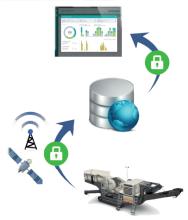Fully utilising the latest preventive machine maintenance technology can help save aggregates production business owners big money annually. Guy Woodford reports in our sister title Aggregates Business.
Crushing and screening equipment are key assets that keep aggregate producers’ businesses running smoothly and efficiently. But with mobile crushers moving frequently between sites, often in remote areas, it can be difficult to track, monitor and maintain these types of equipment to ensure their performance. Without having the right information at the right time to make important operational or maintenance decisions, extended downtime can quickly set in and production rates can suffer, challenging producers bottom lines.
Metso’s Metso Metrics technology for aggregates customers helps monitor, maintain and manage clients’ assets.
Connected equipment is ensured by many advanced sensors installed on each plant, tracking various elements around the performance of the machine.
An intuitive interface, accessible through any internet-connected device, allows the customer to know exactly what is happening with their equipment 24/7.
Metso teams, combining global and local expertise, can also use Metso Metrics to monitor customer assets, allowing them to better meet customer plant maintenance and servicing needs and helping to troubleshoot issues remotely.
Fitted as standard on Metso Lokotrack LT mobile jaw and cone crushers and Lokotrack ST mobile screens since its launch in 2016, Metso Metrics for Aggregates can also be retrofitted on older plant models.
From Metso Metrics for Aggregates, users can see key data for their whole fleet connected to Metrics. When logged in, the user can see right away combined data from their fleet in KPI (key performance indicator) windows. This includes fleet operating hours, fuel/power consumption, next maintenance events and machine location for each machine. There are many other KPI windows and users can customise their main page view to show what they want to see when they log in.
Users can also open and see machine-specific data sheets by clicking the machine from the fleet. From here, users can see how the machine has been running each day during the time it has been connected into Metso Metrics. Data shown for the machines are operating hours, fuel/power consumption, upcoming maintenance events, maintenance log, alarm log, parameter changes and machine location. If belt scales are installed, then it’s possible to show tonnage data in Metso Metrics from the machine.
Users can run different reports from their fleet or specific machines in Metso Metrics. Also, users can order email notifications for upcoming maintenance events and active alarms about which users want to be notified.
The benefits of Metso Metrics can be summarised under three headings:
Get the most out of assets - Critical maintenance and operational data at the touch of a button, helping a company identify underperforming assets and training opportunities for continuous improvement. With access to the right data, a firm can take appropriate actions for improved utilisation rates and operational efficiency, so it gets the most out of its assets.
Improved operational efficiency - Helping to reduce routine site checks and manual reporting by providing remote visibility and reporting on the condition and performance of a company’s productive crushing and screening assets.
Lower operational costs - Helping to lower a business’s inventory costs by mapping out which parts are required for upcoming service events. With the maintenance plans of its equipment integrated into Metso’s solution, a firm can stay on top of its equipment needs and make sure it has the right parts available at the right time, helping to control maintenance and upfront inventory costs.
The state-of-the-art Metso Metrics technology is popular among quarry customers and plant hire companies.
Anthony Ryan, sales manager for McHale Plant Sales, based in Tipperary, Ireland, says Metso Metrics is “very useful” for preventative plant maintenance and servicing.
“We can predict when a plant service is needed, allowing us to better prepare our engineers. Also, if you get a call from a customer saying that a plant alarm is on, you can see where on the plant the alarm has been activated and offer appropriate advice.
“Metso Metrics also enables our engineers to see exactly where a machine is, helping them to locate it as quickly as possible, rather than potentially having to phone and ask for further directions to a customer site. You can make useful notes on the system, such as when a servicing was last completed and when the next one will be due, or when parts will next need changing. You can also create records highlighting specific servicing and maintenance milestones.”
Speaking to Aggregates Business, Jari Hytti, manager, field service applications, Metso, says Metso plant hire companies and distributors also use Metso Metrics to print off monthly reports of plant usage in order to accurately invoice rental customers.
“There are just over 800 machines connected to Metso Metrics for Aggregates globally and sending data to the portal. On average there are around 30 new machines connected to Metrics every month.
“It has recently been made standard on all new Metso C-Series jaw crushers and GP-Series cone crushers with Metso IC plant automation control. In the coming months, we also plan to make the technology available on MX and HP-Series cone crushers, and Nordwheeler portable plants,” he explains.
“We are also developing a benchmarking tool, which will be ready by the end of this year, so we can compare how they are running their Metso plant compared to other local Metso plant operators locally and globally. Following customer feedback, we are also working on making Metso Metrics portal more mobile device screen-compatible.”
Metso is starting to develop a new feature that allows Metso Metrics to categorise Metso IC plant automation control-generated fault alarms, depending on their production criticality.
“We will develop Metso Metrics so when the most critical plant fault alarm is activated, let’s say three times in one day, the solution will automatically email Person X saying, ‘This is urgent. Please take action.’ A category two alarm might mean that an alarm will need to be activated five times in one day to prompt the same automatic email. Category three alarm automatic emails might be sent only after ten alarm activations are recorded in one day. Faults may include operating pressure being too high, which could lead to a major plant breakdown if ignored.”
Hytti adds: “We are using a dual-type modem which includes satellite and SIM card compatibility. For remote work sites where there is no terrestrial GSM [global system for mobile communications] network, the satellite should allow Metso Metrics to work everywhere except when the machine is in a tunnel, for example, as the satellite needs to ‘see’ the machine. With the SIM card, it allows you to use Metso Metrics when there is a GSM network on-site. In some countries where the government bans the use of satellites for communications, we offer SIM-only modems for accessing Metso Metrics.”
In Germany, Metso Metrics is currently being used by 52 Metso crushing and screening plant customers nationally, working in the quarrying, gravel processing and recycling sectors.
Hugo van Benthem, distribution business manager, Metso, Germany, and Ralph Phlippen, co-owner and sales manager of Metso Germany’s distributor, Fischer Jung, have been pleased with the rental and owner-plant customer response to Metso Metrics, since its introduction nationally a year ago.
“In Germany, we have 52 Metso quarrying, recycling and gravel customer machines using Metso Metrics,” says van Bentham. “The interest from the customer is in answering questions like, ‘Is the unit running?’, ‘Are there any issues?’. The interest from the Metso service engineers is ‘Is there any scheduled servicing coming up soon?’ and in being able to troubleshoot the plant from distance. It’s a huge benefit in being able to see any alarms from, say, 400 kilometres away.
“Generally, plant units with the highest number of operating hours will gain the biggest benefits from Metso Metrics.”
Phlippen adds: “In the past, in 50% of cases where a problem with the plant has been reported we could advise the customer over the phone to ‘press this’ or ‘check that’, but with Metso Metrics we can look at the plant ourselves and properly advise the customer 80% of the time. We can support the customer in optimising the performance of the plant for each specific application.
“Through Metso Metrics, Metso can also advise on what filter kits are needed so a service technician can fill up the car with the appropriate filters before he drives there.”
Karl-Werner Bierbrauer uses Metso Metrics with his Metso plant fleet at Bierbrauer und Sohn’s quarry in Kretz, Rhineland-Palatinate, South-West Germany.
“With Metso Metrics, I can follow my units and their production. But most important, however, is the fast troubleshooting it offers,” says Bierbrauer.
Volvo Construction Equipment (Volvo CE) is highlighting why oil analysis should play a critical part in a company’s machine maintenance programme.
“Oil is the lifeblood of a machine. Regular checks help monitor its health, which is vital for maintaining maximum uptime and minimum total cost of ownership,” a company spokesperson said.
Volvo CE says oil analysis is an unbeatable tool in increasing machine performance, which means increased profits. Based on data collected by analysis results, the manufacturer says customers can spot machine errors and plan maintenance, which reduces the risk of unplanned downtime, prevents expensive repairs and increases productivity.
Volvo laboratories, featuring modern diagnostic equipment, provide customers with a comprehensive report on machine condition. After thorough analysis takes place, machine diagnoses immediately become available to customers online, highlighting warnings and providing action recommendations. Thanks to these reports, every part of the machine can operate at maximum capacity with little risk of fault, keeping uptime levels high.
Oil sample analysis collects information on water/coolant content, impurities and quality of metal particles in the fuel. Performing regular oil analysis checks records a history of results and allows for laboratory technicians and customers to see trends in machine performance.
Fuel supports vital machine components including the engine, transmission, axles, brakes and hydraulics system. Volvo laboratories, equipped with full knowledge of Volvo machines, can interpret how functional these components are based on oil analysis. This provides technicians with early warnings signals for machine parts, giving customers time to replace any components that are susceptible to damage or failure.
Overall, Volvo CE says that oil analysis is the most practical action. It is an excellent planning tool to give you better control on productivity, maintenance, potential failure and avoidance of downtime.











